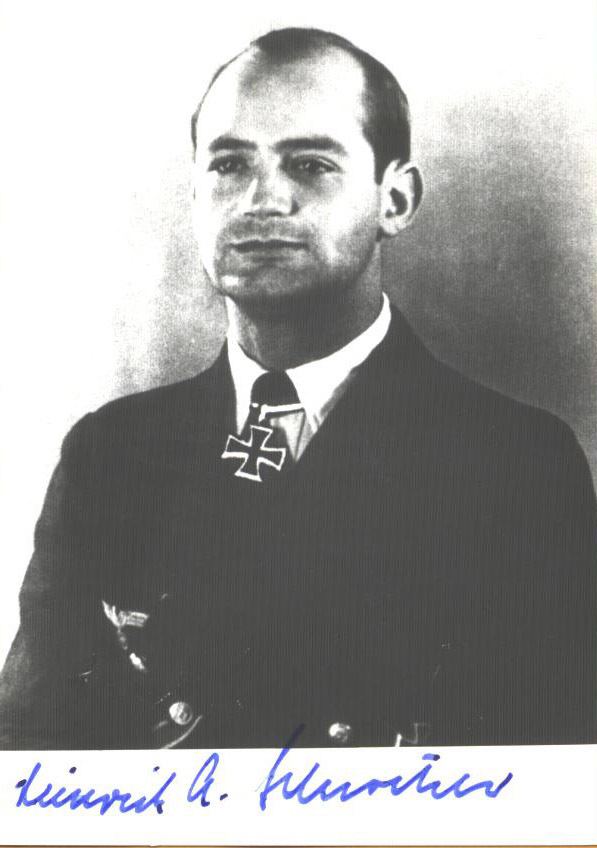Name Heinrich Schroeteler | Years of service 1936–45 | |
 | ||
Born 10 December 1915Essen-Katernberg ( 1915-12-10 ) Unit SchlesienPanzerschiff Admiral ScheerU-96 Battles/wars World War IIBattle of the AtlanticActions of 7/8 May 1945Operation Deadlight | ||
Other work Art history, Sculpture | ||
Dr. Heinrich Andreas Schroeteler (10 December 1915 – 19 January 2000) German sculptor. During World War II, he commanded U-boat and received the Knight's Cross of the Iron Cross (German: Ritterkreuz des Eisernen Kreuzes); during the post-war years, he pursued a career in art history and archeology.
Contents

Family
Schroeteler was born in Essen in 1915, one of eleven children. He followed his family's tradition of marine service in 1936.
Military career
Schroeteler was credited with damaging one merchant ship, the British steam merchant Riverton, of 7,345 gross register tons (GRT), and sinking one warship, the Norwegian minesweeper HNoMS NYMS-382, of 335 GRT. The sinking took place on 7 May 1945, three days after the U-boats had been ordered to surrender. Subsequently, Schroeteler transferred to the U-boat service in September 1941 and sailed on one patrol from 23 April 1942 to 15 July 1942 on U-96 as a Kommandantenschüler (commander-in-training) under the command of Hans-Jürgen Hellriegel. He spent three years as a prisoner of war in England before returning to Germany in 1948.
Artist
Following the war, he worked as a free-lance painter in Bochum. Schroeteler, at the age of 50 years, began his studies of art history, archeology and medieval history at the Ruhr University Bochum. After his graduation in 1969 he worked as a research associate at the Institute of Archaeology. He led the modeling workshop, and was curator of collections. His success as a reconstructor of ancient works of art was honored with the University Medal from the Ruhr University in 1981. Under the leadership of Bernard Andreae, Schroeteler together with Silvano Bertolin, worked on the plastic reconstruction of the "The blinding of Polyphemus".
Demagogue
The historian Hans H. Hanke summarized Schroeteler's biography in a memorandum written for Bochum's Committee on Culture and Sport (Ausschuss für Kultur und Sport) dated 5 February 2014. According to Hanke, Schroeteler remained an agitator of National Socialism his entire life. Hanke attributed this statement to the fact that Schroeteler hosted numerous meetings of former German U-boat and British submarine crews in his atelier under the banner of the Reichskriegsflagge. In addition, Schroeteler supported the political views of the Neo-Nazis, in particular where these views matched his ambitions "to do justice to the Wehrmacht merits for its country" ("den Verdiensten der Wehrmacht um das Vaterland gerecht zu werden") and to "reestablish the Wehrmachts honour abroad" ("um die Ehre der deutschen Wehrmacht im Ausland wiederherzustellen").
Schroeteler also attended Großadmiral (grand admiral) Karl Dönitz funeral. Dönitz was the former Commander-in-Chief of the Kriegsmarine, Adolf Hitler's successor as the head of state of Nazi Germany and convicted war criminal at the Nuremberg trials. There, Schroeteler was one of the six pallbearers who carried Dönitz to his grave, all six wearing their wartime Knight's Crosses.
Finally, Schroeteler allowed himself to be photographed wearing his uniform and Knight's Cross and sent signature postcards to interested people. He also supported war glamorizing publications. Hanke stated that he has no sympathy for Schroeteler's ambitions to rehabilitate the Wehrmacht which fostered the myth of the clean Wehrmacht. Hanke believes that Schroeteler should have used his position as an academic and artist to distance himself from the political right.
